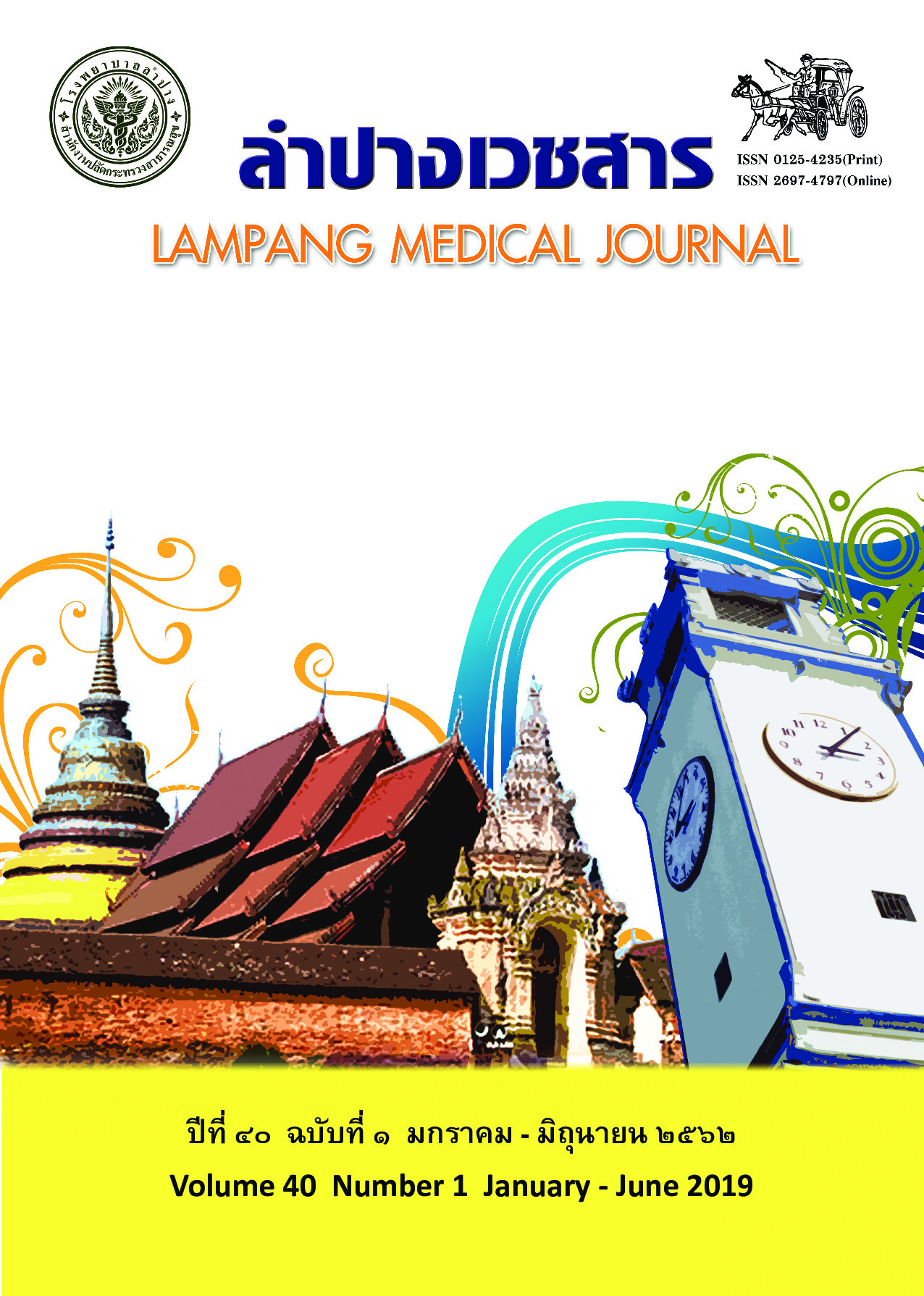Surgical Treatment for Unstable Pelvic and Acetabular Fractures at Chiang Rai Prachanukroh Hospital: Over 2-years of Clinical Results
Main Article Content
Abstract
Background: Surgical treatment of unstable pelvic fractures and acetabular fractures can decrease the patient morbidity and disability. In Thailand, the studies about the intermediate outcomes of this issue have been limited.
Objective: To determine the intermediate surgical outcomes for unstable pelvic and acetabular fractures at Chiang Rai Prachanukroh Hospital.
Material and method: A descriptive questionnaires–based study was carried out in patients with unstable pelvic and acetabular fractures, who underwent surgical treatment between January 2014 and May 2017. Demographic and radiographic data were collected from electronic medical records, and a postoperative survey was achieved by the SF-36 questionnaire Thai version 2.
Results: Within the pelvic fractures group, there were 5 men and 5 women with a mean age of 40.8 ± 17.5 years old (range, 19-70). Fractures were classified as LC type in 6 cases and APC type in 4 cases. The average follow-up period was 47.7 ± 10.3 months (range, 24-62). In the acetabular fractures group, there were 16 men and 6 women with a mean age of 35.5 ± 13.9 years old (range, 15-68). Fractures were classified as type A in 5, B in 14, and C in 3 cases. The average follow-up period was 47.0 ± 10.3 months (range, 24-66). Postoperatively, the mean SF-36 scores were comparable in both groups of fractures. The highest scores were found in the domain of role limitations due to emotional problems, and the lowest scores were found in the domain of energy and vitality. Seven of 8 domains demonstrated lower scores than those of the normal Thai population.
Conclusion: The patients with unstable pelvic and acetabular fractures had comparable quality of life, determined by SF-36 scores. The scores in surgically treated patients were lower than in the normal population.
Article Details
บทความที่ส่งมาลงพิมพ์ต้องไม่เคยพิมพ์หรือกำลังได้รับการพิจารณาตีพิมพ์ในวารสารอื่น เนื้อหาในบทความต้องเป็นผลงานของผู้นิพนธ์เอง ไม่ได้ลอกเลียนหรือตัดทอนจากบทความอื่น โดยไม่ได้รับอนุญาตหรือไม่ได้อ้างอิงอย่างเหมาะสม การแก้ไขหรือให้ข้อมูลเพิ่มเติมแก่กองบรรณาธิการ จะต้องเสร็จสิ้นเป็นที่เรียบร้อยก่อนจะได้รับพิจารณาตีพิมพ์ และบทความที่ตีพิมพ์แล้วเป็นสมบัติ ของลำปางเวชสาร
References
2. Alton TB, Gee AO. Classifications in brief: Young and Burgess classification of pelvis ring injuries. Clin Orthop Relat Res 2014;472(8):2338-42.
3. Leurmarnkul W, Meetam P. Properties testing of the retranslated SF-36 (Thai version). Thai J Pharm Sci 2005;29(1-2):69-88.
4. Lynette LL, Seubsman S, Sleigh A. Thai SF-36 health survey: tests of data quality, scaling assumptions, reliability and validity in healthy men and women. Health Qual Life Outcomes
2008;6:52.
5. Mears DC, Velyvis JH, Chang CP. Displaced acetabular fractures managed operatively: indicators of outcome. Clin Orthop Relat Res 2003;407:173-86.
6. Suzuki T, Shindo M, Soma K, Minehara H, Nakamura K, Uchino M, et al. Long-term functional outcome after unstable pelvic ring fracture. J Trauma 2007;63(4):884-8.
7. Lefaivre KA, Slobogean GP, Ngai JT, Broekhuyse HM, O’Brien PJ. What outcomes are important for patients after pelvic trauma? Subjective responses and psychometric analysis of
three published pelvic-specific outcome instruments. J Orthop Trauma 2014;28(1):23-7.
8. Oliver CW, Twaddle B, Agel J, Routt ML Jr. Outcome after pelvic ring fractures: evaluation using the medical outcomes short form SF-36. Injury 1996;27(9):635-41.
9. Phruetthiphat O, Willey M, Karam MD, Gao Y, Westerlind BO, Marsh JL. Comparison of outcomes and complications of isolated acetabular fractures and acetabular fractures with
associated injuries. J Orthop Trauma 2017;31(1):31-6.
10. Borg T, Berg P, Larsson S. Quality of life after operative fixation of displaced acetabular fractures. J Orthop Trauma 2012;26(8):445-50.
11. Frietman B, Biert J, Edwards MJR. Patient-reported outcome measures after surgery for an acetabular fracture. Bone Joint J 2018;100-B(5):640-5.
12. Kongsakon R, Silpakit C, Udomsubpayakul U. Thailand normative data for the SF-36 health survey: Bangkok metropolitan. Asian J Psychiatr 2007:8(2):131-7.


